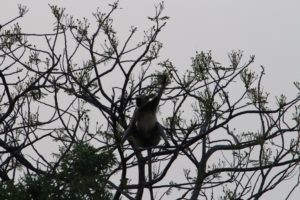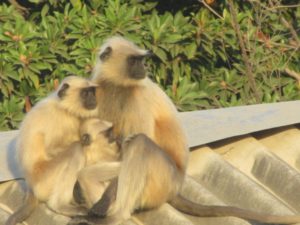
The Langurs of Sevagram
Sevagram is synonymous with Mahatma Gandhi. He spent a large part of his life here during India’s freedom struggle. And one of his prized possessions was a tiny figurine of three wise monkeys who embodied the principles “see no evil, hear no evil, and speak no evil”. These monkeys are now part of the country’s cultural legacy.

Gandhi’s three wise monkeys
Gandhiji is now gone. But whenever I see the langurs frolicking around my garden, I always mumble that Gandhi’s friends are back. Sevagram has several troops of these revered animals. It is normal to wake up in the morning and hear their whoops from the tall trees in the vicinity.

Gray langurs or Hanuman langurs, as they are better known, are among the commonest species of monkeys seen in the Indian subcontinent. These are usually terrestrial animals, preferring to stay on the top branches of trees. But in urban habitats they do descend on the ground when it comes to foraging for food.

Companionship

Sweet nothings
These langurs are highly social beings and it is a study in itself to watch them interact. The troops that I see in Sevagram are mixed groups, usually having a dominant male with several females and offspring. The males tend to be more aggressive if there are several babies in the troop. Usually there is a single dominant male, but I have spotted groups with more than one male. The hierarchies are clearly laid out. Females in a group tend to be friendly and do several activities together. You will usually find them grooming each other or rearing the children. However relationships between males tend to be hostile. Adult males usually leave groups depending on who is dominant.

Family portrait?

The community grooming session

Isn’t she enjoying the attention?

Junior wants to play

Now something has caught Junior’s attention

Oh! The roof will fly off tonight! He is unscrewing the nuts and bolts
The langurs do not usually attack if you leave them alone. But if they feel threatened the males tend to show their teeth and chase you. They have a tendency to create chaos in our gardens. My kitchen garden is their target and anything I grow is usually finished before I get a chance at sampling it. And my pet peeve is when they decide to relax in my rose garden and carefully eat rose bud after rose bud. Especially when I count over 70 roses in the morning and then see all of them gone by lunch, I blow a fuse. My neighbours have learnt to save the fire crackers from their Diwali stock to chase them away when their gardens are attacked. The langurs can create a ruckus on hot afternoons running over the asbestos roofs loudly.

Temperatures reach over 45 degrees C in summers in Sevagram and then you feel their distress. They have now learnt to open the taps in my garden and drink from the hose. It is fascinating to watch them teach their young to drink from the hose and climb up the poles.




Eventually I guess the residents of Sevagram and the langurs have learnt to live in harmony. This place is theirs, as much as it is ours.
Share this:
- Click to share on Twitter (Opens in new window)
- Click to share on Facebook (Opens in new window)
- Click to print (Opens in new window)
- Click to share on WhatsApp (Opens in new window)
- Click to share on Tumblr (Opens in new window)
- Click to share on Pinterest (Opens in new window)
- Click to email this to a friend (Opens in new window)
Related


3 Comments
Monika Kalra
This place is theirs, as much as it is ours….. how lovely 💕
Smita
Community lessons to be learnt from them 😍😍
Mrinalini
I hope they turn off the taps too when done drinking!